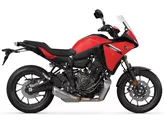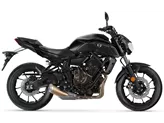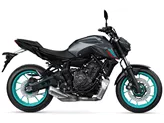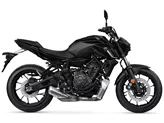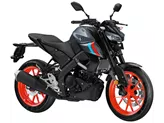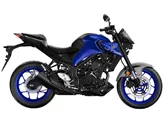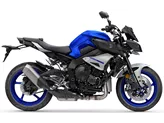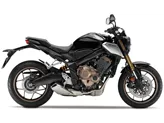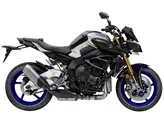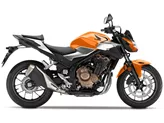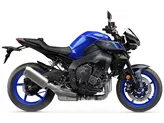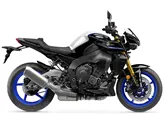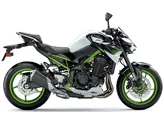Yamaha MT-07 2018 vs. Yamaha MT-10 2016

Yamaha MT-07 2018

Yamaha MT-10 2016
Vue d’ensemble - Yamaha MT-07 2018 vs Yamaha MT-10 2016
The Yamaha MT-07 2018 and the Yamaha MT-10 2016 are both naked bikes from Yamaha, but they have several differences in terms of technical specifications and strengths.
Starting with the technical specifications, the Yamaha MT-07 2018 is equipped with a 689cc in-line engine that produces 75 horsepower and 68 Nm of torque. It has a liquid cooling system and a two-cylinder configuration. On the other hand, the Yamaha MT-10 2016 features a larger 998cc in-line engine that delivers a more powerful 160 horsepower and 111 Nm of torque. It also has a liquid cooling system but has a four-cylinder configuration, providing even more power.
In terms of suspension, the Yamaha MT-07 2018 has a telescopic fork front suspension, while the Yamaha MT-10 2016 is equipped with an upside-down telescopic fork front suspension. This difference in suspension design may affect the handling and stability of the bikes.
The chassis of the Yamaha MT-07 2018 is made of steel, while the Yamaha MT-10 2016 has an aluminum frame. The choice of materials for the frame can impact the overall weight and rigidity of the bikes.

Yamaha MT-07 2018
Both bikes have double disk front brakes, ensuring powerful braking performance. The front tire width for both models is the same at 120mm, but the rear tire width differs slightly, with the Yamaha MT-07 2018 having a 180mm width and the Yamaha MT-10 2016 having a wider 190mm width. The wheelbase and seat height are the same for both models, with a wheelbase of 1400mm and a seat height of 805mm for the Yamaha MT-07 2018 and 825mm for the Yamaha MT-10 2016.
In terms of weight, the Yamaha MT-07 2018 is lighter, with a kerb weight (with ABS) of 182kg, compared to the Yamaha MT-10 2016, which weighs 210kg. The fuel tank capacity is also different, with the Yamaha MT-07 2018 having a 14-liter capacity and the Yamaha MT-10 2016 having a larger 17-liter capacity.
Moving on to the strengths of each bike, the Yamaha MT-07 2018 is praised for its extremely agile engine and very light handling. It also has a low weight, which contributes to its nimble performance. The aggressively angular look of the bike adds to its appeal, and the powerful brakes ensure effective stopping power. The comfortable seating position and throaty sound further enhance the riding experience.

Yamaha MT-10 2016
On the other hand, the Yamaha MT-10 2016 is known for its CP4 engine, which gives it a strong character and provides exhilarating performance. It is also highly agile and offers high-speed stability. The strong brakes and unmistakable sound add to the overall experience of riding this bike.
However, both bikes have their weaknesses. The Yamaha MT-07 2018 has a chassis that is considered a little soft, and the footrests tend to drag quickly in corners. Some cheap plastic parts on the bike may also affect its overall quality. Additionally, the telescopic fork front suspension is considered boring, and the instruments could be easier to read.
On the other hand, the Yamaha MT-10 2016 has poor comfort, limited wind protection, and a hard fit, which may affect the overall riding experience, especially during long rides.
In conclusion, the Yamaha MT-07 2018 and the Yamaha MT-10 2016 are both powerful naked bikes from Yamaha, but they have distinct differences in terms of technical specifications and strengths. The Yamaha MT-07 2018 is lighter and offers a more comfortable riding position, while the Yamaha MT-10 2016 has a more powerful engine and provides a thrilling riding experience. Both bikes have their weaknesses, but they still offer unique features that cater to different riders' preferences.
Caractéristiques techniques Yamaha MT-07 2018 par rapport à Yamaha MT-10 2016
Avantages et inconvénients en comparaison
Avantages et inconvénients en comparaison
Yamaha MT-07 2018

La MT-07 est une incroyable machine de plaisir qui se laisse conduire de manière extrêmement sportive. Les freins sont très puissants, la maniabilité est excellente et le moteur est de loin le plus agile de sa catégorie - et même au-delà. La maniabilité s'y prête parfaitement et le design agressif avec ses nombreux angles et arêtes peut également plaire. Seul le châssis fait le bon compromis typique entre confort et sport et doit probablement rappeler que la MT-07 bon marché a aussi quelque chose à offrir aux débutants.
Yamaha MT-10 2016

La MT-10, courte et trapue, est la plus éloignée de la superbike R1, tant au niveau de l'esthétique que du châssis, mais le cœur de la MT-10 est directement issu de l'arme de la piste de course et fascine par sa sonorité brute unique et sa force d'attaque par le bas grâce au décalage typique des tourillons qui, avec une séquence d'allumage modifiée, lui confère ce caractère unique. Les 160 ch qui en résultent ne semblent donc que sur le papier un peu faibles par rapport aux plus de 200 ch de la R1, mais en réalité, la MT-10 déclenche elle aussi un feu d'artifice incroyable. Le châssis serait probablement trop souple pour la piste de course, mais il est tout à fait adapté à un combat sur route et le freinage fait de même - acceptable pour la piste, mais parfait pour la route.
Comparaison des prix Prix moyen du marché Yamaha MT-07 vs Yamaha MT-10
There are a few key differences between a Yamaha MT-07 2018 and a Yamaha MT-10 2016. In terms of price, the actual average price of a Yamaha MT-10 2016 is about 57% higher. A Yamaha MT-07 2018 experiences a loss of 150 USD in one year and 300 USD in two years of ownership. This is offset by a loss of 800 USD and 1,840 USD for a Yamaha MT-10 2016. Compared to Yamaha MT-10 2016 there are more Yamaha MT-07 2018 bikes available on the 1000PS.de Marketplace, specifically 28 compared to 7. It takes less time to sell a Yamaha MT-07 with 54 days compared to 97 days for a Yamaha MT-10. Since model year 2013 1000PS.de editors have written 69 reviews for the Yamaha MT-07 and 32 reviews for the Yamaha MT-10 since model year 2016. The first review for the Yamaha MT-07 was published on 11/4/2013 and now has more than 12,600 views. This compares to more than 20,700 views for the first review on Yamaha MT-10 published on 11/17/2015.


